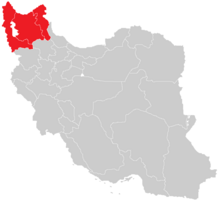Azerbaijan (Iran)
37°36′N 47°00′E / 37.6°N 47.0°EAzerbaijan, also known as Iranian Azerbaijan,[1] is a historical region in northwestern Iran that borders Iraq, Turkey, the Nakhchivan Autonomous Republic, Armenia, and the Republic of Azerbaijan.

Provinces
changeIranian Azerbaijan includes three provinces: West Azerbaijan, East Azerbaijan and Ardabil.[2][3] some sources also include the province of Zanjan and parts of hamadan , markazi , alborz , qazvin and gilan. The region is inhabited by ethnic azeris, with minority populations of Kurds, Armenians, Tats, Talysh, Assyrians and some persians (most of the persians have moved in recently for jobs and work)
History
changeIranian Azerbaijan is the land originally and historically called Azerbaijan, Republic of Azerbaijan appropriated the name of the region in Iran during the 20th century.[4][5][6] Historic Azerbaijan was called Atropatene and Adurbadagan in the pre-Islamic Middle Ages.
After being defeated by Russian Empire, Qajar Persia gave all of its territories in the North Caucasus and Transcaucasia to Russia via the Treaty of Gulistan of 1813 and the Treaty of Turkmenchay of 1828.[7] The territories south of the Aras River, which comprised the region historically known as Azerbaijan, became the new north-west frontier of the Persian Empire and later Iran.[8] The territories north of the Aras River, which were not known by the name Azerbaijan at the time of their capture by Russia, were absorbed into the Russian Empire. It was later incorporated into the Soviet Union as the Azerbaijan Soviet Socialist Republic, and finally became the independent Republic of Azerbaijan when the Soviet Union dissolved.
References
change- ↑ James Minahan. "Miniature Empires", Published by Greenwood Publishing Group, 1998.
- ↑ "Azerbaijan: Region, Iran". Encyclopedia Britannica. Archived from the original on 2020-04-20. Retrieved 2019-10-06.
- ↑ The Encyclopaedia of Islam, Volume XI (Brill Publishers, Leiden, 2002). Article: "Zandjan", page 446:
The mediaeval geographers mostly placed Zandjan in Djibal province, usually linking it with Abhar [q.v] or Awhar some 80 km/50 miles to its south-east, but they usually stated that it was on the frontier with Adharbaydjan, and some authorities attributed it to Daylam or to Rayy.
- ↑ Atabaki, Touraj (2000). Azerbaijan: Ethnicity and the Struggle for Power in Iran. I.B.Tauris. p. 25. ISBN 9781860645549.
- ↑ Dekmejian, R. Hrair; Simonian, Hovann H. (2003). Troubled Waters: The Geopolitics of the Caspian Region. I.B. Tauris. p. 60. ISBN 978-1860649226. Retrieved 2020-11-08.
Until 1918, when the Musavat regime decided to name the newly independent state Azerbaijan, this designation had been used exclusively to identify the Iranian province of Azerbaijan.
- ↑ Rezvani, Babak (2014). Ethno-territorial conflict and coexistence in the caucasus, Central Asia and Fereydan: academisch proefschrift. Amsterdam: Amsterdam University Press. p. 356. ISBN 978-9048519286.
The region to the north of the river Araxes was not called Azerbaijan prior to 1918, unlike the region in northwestern Iran that has been called since so long ago.
- ↑ Swietochowski, Tadeusz (1995). Russia and Azerbaijan: A Borderland in Transition. Columbia University Press. pp. 69, 133. ISBN 978-0-231-07068-3. Retrieved 2020-11-08.
- ↑ Timothy C. Dowling Russia at War: From the Mongol Conquest to Afghanistan, Chechnya, and Beyond pp 728–729 ABC-CLIO, 2 dec. 2014 ISBN 1598849484